SNOSB80C February 2011 – October 2015 LMP8350
PRODUCTION DATA.
6 Specifications
6.1 Absolute Maximum Ratings(1)(2)(6)
| MIN | MAX | UNIT | ||
|---|---|---|---|---|
| Output short circuit duration | See (4) | |||
| V+ relative to V– | –0.3 | 12.9 | V | |
| IN+, IN–, OUT, EN and VOCM pins | (V+) + 0.3 | (V–) – 0.3 | V | |
| Input current | 1 | mA | ||
| Junction temperature(5) | 150 | °C | ||
| Storage temperature, Tstg | −65 | 150 | °C | |
(1) Stresses beyond those listed under Absolute Maximum Ratings may cause permanent damage to the device. These are stress ratings only, which do not imply functional operation of the device at these or any other conditions beyond those indicated under Recommended Operating Conditions. Exposure to absolute-maximum-rated conditions for extended periods may affect device reliability.
(2) If Military/Aerospace specified devices are required, please contact the TI Sales Office/ Distributors for availability and specifications.
(3) Human Body Model, applicable std. MIL-STD-883, Method 3015.7. Machine Model, applicable std. JESD22-A115-A (ESD MM std. of JEDEC). Field-Induced Charge-Device Model, applicable std. JESD22-C101-C (ESD FICDM std. of JEDEC).
(4) The short circuit test is a momentary test which applies to both single-supply and split-supply operation. Continuous short circuit operation at elevated ambient temperature can exceed the maximum allowable junction temperature of 150°C. Positive number (+) is sourcing, negative number (–) is sinking.
(5) The maximum power dissipation is a function of TJ(MAX), θJA. The maximum allowable power dissipation at any ambient temperature is PD = (TJ(MAX) – TA)/ θJA. All numbers apply for packages soldered directly onto a PC Board.
(6) For soldering specifications: SNOA549
6.2 ESD Ratings
| VALUE | UNIT | |||
|---|---|---|---|---|
| V(ESD) | Electrostatic discharge | Human body model (HBM), per ANSI/ESDA/JEDEC JS-001(1)(3) | ±2500 | V |
| Charged-device model (CDM), per JEDEC specification JESD22-C101(2) | ±1250 | |||
| Machine Model | ±200 | |||
(1) JEDEC document JEP155 states that 500-V HBM allows safe manufacturing with a standard ESD control process. Manufacturing with less than 500-V HBM is possible with the necessary precautions.
(2) JEDEC document JEP157 states that 250-V CDM allows safe manufacturing with a standard ESD control process.
6.3 Recommended Operating Conditions
See (1)| MIN | MAX | UNIT | ||
|---|---|---|---|---|
| Temperature range (TA) | –40 | 85 | °C | |
| Supply voltage (VS = V+ – V–) | 4.5 | 12 | V | |
(1) Absolute Maximum Ratings indicate limits beyond which damage to the device may occur. Operating Ratings indicate conditions for which the device is intended to be functional, but specific performance is not ensured. For ensured specifications and the test conditions, see the Electrical Characteristics Tables.
(2) The maximum power dissipation is a function of TJ(MAX), θJA. The maximum allowable power dissipation at any ambient temperature is PD = (TJ(MAX) – TA)/ θJA. All numbers apply for packages soldered directly onto a PC Board.
6.4 Thermal Information
| THERMAL METRIC(1) | LMP8350 | UNIT | |
|---|---|---|---|
| D (SOIC) | |||
| 8 PINS | |||
| RθJA | Junction-to-ambient thermal resistance (2) | 150 | °C/W |
(1) For more information about traditional and new thermal metrics, see the Semiconductor and IC Package Thermal Metrics application report, SPRA953.
6.5 10-V Electrical Characteristics
Unless otherwise specified, all limits are ensured for TA = 25°C, Avcl = +1, RF = RG = 1 kΩ, Fully differential input, VS = +10 V, RL = 2 kΩ//20 pF differentially, Input CMR and VOCM = mid-supply and HP mode unless otherwise noted.(1)| PARAMETER | TEST CONDITIONS(2) | MIN(3) | TYP(4) | MAX(3) | UNIT | ||
|---|---|---|---|---|---|---|---|
| 10-V DC CHARACTERISTICS | |||||||
| VOS | Input offset voltage (RTI) |
High power | TA = 25°C | ±0.6 | ±4 | mV | |
| At the temperature extremes | ±4.05 | ||||||
| Mid power | TA = 25°C | ±0.08 | ±2 | ||||
| At the temperature extremes | ±2.03 | ||||||
| Low power | TA = 25°C | ±0.1 | ±2.5 | ||||
| At the temperature extremes | ±2.52 | ||||||
| TCVOS | Input offset voltage vs.temperature(5) | High power | ±0.8 | μV/°C | |||
| Mid power | ±0.5 | ||||||
| Low power | ±0.4 | ||||||
| IB | Input bias current | High power | TA = 25°C | 2 | μA | ||
| At the temperature extremes | 2.1 | ||||||
| Mid power | TA = 25°C | 2.7 | |||||
| At the temperature extremes | 3.2 | ||||||
| Low power | TA = 25°C | 3.5 | |||||
| At the temperature extremes | 3.7 | ||||||
| AVOL | Open-loop gain | High power | 65 | 90 | dB | ||
| Mid power | 72 | 130 | |||||
| Low power | 74 | 114 | |||||
| CMVR | Common-mode voltage range(6) | HP at CMRR ≥ 73 dB | 1.2 | 8.8 | V | ||
| MP at CMRR ≥ 83 dB | 1.2 | 8.8 | |||||
| LP at CMRR ≥ 77 dB | 1.2 | 8.8 | |||||
| CMRR | Common-mode rejection ratio | DC, VOCM = 0,VID = 0, ΔVcm = ±0.2 V, High power | 75 | 90 | dB | ||
| Medium power | 84 | 130 | |||||
| Low power | 79 | 114 | |||||
| ZIND | Differential input resistance | VCM = mid-supply | 0.48 | MΩ | |||
| CIND | Differential input capacitance | VCM = mid-supply | 1 | pF | |||
| VO | Output swing (single-ended) |
High power | Low Swing | 0.86 | 0.75 | 9.14 | V |
| High Swing | 0.86 | 9.25 | 9.14 | ||||
| Mid power | Low Swing | 0.85 | 0.74 | 9.15 | |||
| High Swing | 0.85 | 9.26 | 9.15 | ||||
| Low power | Low Swing | 0.86 | 0.81 | 9.14 | |||
| High Swing | 0.86 | 9.19 | 9.14 | ||||
| ISHORT | Short-circuit current | Output shorted to mid-supply(7)
High power |
Low Swing | –36 | -65 | mA | |
| High Swing | 75 | 108 | |||||
| Medium power | Low Swing | -26 | -48 | ||||
| High Swing | 60 | 85 | |||||
| Low power | Low Swing | -6 | -20 | ||||
| High Swing | 15 | 36 | |||||
| PSRR | Power supply rejection ratio VS ±10% |
High power | 107 | dB | |||
| Mid power | 118 | ||||||
| Low power | 124 | ||||||
| IS | Supply current | VEN = 8.75(8) | TA = 25°C | 15 | 18 | mA | |
| At the temperature extremes | 20 | ||||||
| VEN = 6.25(8) | TA = 25°C | 8 | 10 | ||||
| At the temperature extremes | 11 | ||||||
| VEN = 3.75(8) | TA = 25°C | 3 | 4 | ||||
| At the temperature extremes | 5 | ||||||
| PD | Power-down mode | Disable voltage threshold(8) | < 1.65 | V | |||
| Shutdown current | TA = 25°C | 0.75 | 0.9 | mA | |||
| At the temperature extremes | 0.95 | ||||||
| Enable pin current | 100 | μA | |||||
| ten | Enable time | High power | 15 | ns | |||
| Mid power | 20 | ||||||
| Low power | 40 | ||||||
| 10-V AC CHARACTERISTICS | |||||||
| SSBW | Small signal bandwidth 200 mVp-p differential |
High power | 118 | MHz | |||
| Mid power | 87 | ||||||
| Low power | 31 | ||||||
| SR | Slew rate 2 Vp-p differential(9) |
High power | 507 | V/μs | |||
| Mid power | 393 | ||||||
| Low power | 178 | ||||||
| trise | Rise time 2 Vp-p differential |
High power | 3 | ns | |||
| Mid power | 3.9 | ||||||
| Low power | 9.7 | ||||||
| tfall | Fall time 2 Vp-p differential |
High power | 2.8 | ns | |||
| Mid power | 3.8 | ||||||
| Low power | 9.6 | ||||||
| ts | 0.1% settling time 2 Vp-p |
2-V step, CL = 20 pF High power |
20 | ns | |||
| Mid power | 25 | ||||||
| Low power | 38 | ||||||
| en | Input referred voltage noise at 10 KHz |
High power | 4.6 | nV/√Hz | |||
| Mid power | 4.8 | ||||||
| Low power | 8 | ||||||
| In | Input referred current noise at 10 KHz |
f = 10 kHz High power |
1.7 | pA/√Hz | |||
| Mid power | 1.1 | ||||||
| Low power | 0.6 | ||||||
| THD+N | Total harmonic distortion + noise 3 Vp-p at 1 KHz |
High power | 0.000097% | ||||
| Mid power | 0.000109% | ||||||
| Low power | 0.000185% | ||||||
| HD2 | 2nd harmonic distortion 3 Vp-p, 1 KHz |
High power | –124.7 | –116 | dBc | ||
| Mid power | –122.8 | ||||||
| Low power | –117.2 | ||||||
| 2nd harmonic distortion 6 Vp-p, 1 KHz |
High power | –118.9 | dBc | ||||
| Mid power | –117.6 | ||||||
| Low power | –114.7 | ||||||
| HD3 | 3rd harmonic distortion 3 Vp-p, 1 KHz |
High power | –139.9 | –126 | dBc | ||
| Mid power | –141.9 | ||||||
| Low power | –133.3 | ||||||
| 3rd harmonic distortion 6 Vp-p, 1 KHz |
High power | –129.5 | dBc | ||||
| Mid power | –132.4 | ||||||
| Low power | –129.4 | ||||||
| 10-V VOCM INPUT CHARACTERISTICS | |||||||
| VOCM small signal bandwidth 200 mVp-p |
High power | 4.8 | MHz | ||||
| Mid power | 2.4 | ||||||
| Low power | 0.64 | ||||||
| VOCM gain | 1 | V/V | |||||
| VOCM offset voltage | High power | ±1.62 | mV | ||||
| Mid power | ±0.23 | ||||||
| Low power | ±0.43 | ||||||
| VOCM voltage range | All power levels | Low Swing | 1.8 | V | |||
| High Swing | 8.2 | ||||||
| VOCM input resistance | All power levels | Low Swing | 30 | KΩ | |||
| High Swing | mid-supply | ||||||
(1) Electrical Table values apply only for factory testing conditions at the temperature indicated. Factory testing conditions result in very limited self-heating of the device such that TJ = TA. No ensured specification of parametric performance is indicated in the electrical tables under conditions of internal self-heating where TJ > TA
(2) For annotation brevity, “HP”=High Power, “MP”=Medium Power, “LP” =Low Power, “DIS”=Disabled or shut down, “SE”=Single Ended Mode, “DM”=Differential Mode. See Table 1 in Applications section for power setting details. It is also assumed RG = RG1 = RG2
(3) Limits are 100% production tested at 25°C. Limits over the operating temperature range are ensured through correlations using the Statistical Quality Control (SQC) method.
(4) Typical values represent the most likely parametric norm as determined at the time of characterization. Actual typical values may vary over time and will also depend on the application and configuration. The typical values are not tested and are not ensured on shipped production material.
(5) Drift Determined by dividing the change in parameter at temperature extremes by the total temperature change. Value is the worst case of TaMIN to 25°C and 25°C to TaMAX.
(6) At amplifier inputs.
(7) The short circuit test is a momentary test which applies to both single-supply and split-supply operation. Continuous short circuit operation at elevated ambient temperature can exceed the maximum allowable junction temperature of 150°C. Positive number (+) is sourcing, negative number (–) is sinking.
(8) Enable voltage is referred to V– (negative supply voltage).
(9) Slew Rate is the average of the rising and falling edges.
6.6 6.6-V Electrical Characteristics
Unless otherwise specified, all limits are ensured for TA = 25°C, Avcl = +1, RF = RG = 1 kΩ, Fully differential input, VS = +6.6 V, RL = 2 kΩ//20 pF differentially, Input CMR and VOCM = mid-supply and HP mode unless otherwise noted.(1)| PARAMETER | TEST CONDITIONS(2) | MIN(3) | TYP(4) | MAX(3) | UNIT | ||
|---|---|---|---|---|---|---|---|
| 6.6-V DC CHARACTERISTICS | |||||||
| VOS | Input offset voltage (RTI) |
High power | TA = 25°C | ±0.3 | ±3.5 | mV | |
| At the temperature extremes | ±3.54 | ||||||
| Mid power | TA = 25°C | ±0.1 | ±2.8 | ||||
| At the temperature extremes | ±2.83 | ||||||
| Low power | TA = 25°C | ±0.1 | ±2.5 | ||||
| At the temperature extremes | ±2.52 | ||||||
| TCVOS | Input offset voltage vs.temperature(5) | High power | ±0.7 | μV/°C | |||
| Mid power | ±0.5 | ||||||
| Low power | ±0.4 | ||||||
| IB | Input bias current | High power | TA = 25°C | 1.4 | μA | ||
| At the temperature extremes | 2.4 | ||||||
| Mid power | TA = 25°C | 2.5 | |||||
| At the temperature extremes | 3.0 | ||||||
| Low power | TA = 25°C | 3.5 | |||||
| At the temperature extremes | 3.7 | ||||||
| AVOL | Open-loop gain | High power | 65 | 70 | dB | ||
| Mid power | 73 | 76 | |||||
| Low power | 72 | 75 | |||||
| CMVR | Common-mode voltage range(7) | HP at CMRR ≥ 68 dB | 1.2 | 5.4 | V | ||
| MP at CMRR ≥ 63 dB | 1.2 | 5.4 | |||||
| LP at CMRR ≥ 79 dB | 1.2 | 5.4 | |||||
| CMRR | Common-mode rejection ratio | DC, VOCM = 0,VID = 0, ΔVcm = ±0.2 V High power |
70 | 85 | dB | ||
| Mid power | 86 | 117 | |||||
| Low power | 81 | 113 | |||||
| ZIND | Differential input resistance | VCM = mid-supply | 0.48 | MΩ | |||
| CIND | Differential input capacitance | VCM = mid-supply | 1 | pF | |||
| VO | Output swing (single-ended) |
High power | Low Swing | 0.84 | 0.77 | 5.76 | V |
| High Swing | 0.84 | 5.83 | 5.76 | ||||
| Mid power | Low Swing | 0.82 | 0.75 | 5.78 | |||
| High Swing | 0.82 | 5.83 | 5.78 | ||||
| Low power | Low Swing | 0.83 | 0.77 | 5.77 | |||
| High Swing | 0.83 | 5.83 | 5.77 | ||||
| ISHORT | Short-circuit current | Output shorted to mid-supply(6)
High power |
Low Swing | –30 | –49 | mA | |
| High Swing | 54 | 83 | |||||
| Mid power | Low Swing | –19 | –35 | ||||
| High Swing | 40 | 64 | |||||
| Low power | Low Swing | –6 | –15 | ||||
| High Swing | 15 | 27 | |||||
| PSRR | Power supply rejection ratio VS ±10% |
High power | 111 | dB | |||
| Mid power | 117 | ||||||
| Low power | 127 | ||||||
| IS | Supply current | VEN = 5.775(8) | TA = 25°C | 14 | 16 | mA | |
| At the temperature extremes | 18 | ||||||
| VEN = 4.125(8) | TA = 25°C | 7 | 9 | ||||
| At the temperature extremes | 10 | ||||||
| VEN = 2.475(8) | TA = 25°C | 2 | 3 | ||||
| At the temperature extremes | 4 | ||||||
| PD | Power-down mode | Disable voltage threshold(8) | <1.225 | V | |||
| Shutdown current | TA = 25°C | 0.55 | 0.65 | mA | |||
| At the temperature extremes | 0.7 | ||||||
| Enable pin current | 40 | μA | |||||
| ten | Enable time | High power | 18 | ns | |||
| Mid power | 22 | ||||||
| Low power | 43 | ||||||
| 6.6-V AC CHARACTERISTICS | |||||||
| SSBW | Small signal bandwidth 200 mVp-p differential |
High power | 116 | MHz | |||
| Mid power | 85 | ||||||
| Low power | 29 | ||||||
| SR | Slew rate 2 Vp-p differential(9) |
High power | 488 | V/μs | |||
| Mid power | 376 | ||||||
| Low power | 166 | ||||||
| trise | Rise time 2 Vp-p differential |
High power | 3.1 | ns | |||
| Mid power | 4.2 | ||||||
| Low power | 10.4 | ||||||
| tfall | Fall time 2 Vp-p differential |
High power | 3.0 | ns | |||
| Mid power | 4.0 | ||||||
| Low power | 10.3 | ||||||
| ts | 0.1% settling time 2 Vp-p |
2-V step, CL = 20 pF High power |
19 | ns | |||
| Mid power | 25 | ||||||
| Low power | 43 | ||||||
| en | Input referred voltage noise at 10KHz |
High power | 4.5 | nV/√Hz | |||
| Mid power | 4.8 | ||||||
| Low power | 8 | ||||||
| In | Input referred current noise at 10KHz |
High power | 1.7 | pA/√Hz | |||
| Mid power | 1.2 | ||||||
| Low power | 0.6 | ||||||
| THD+N | Total harmonic distortion + noise 3 Vp-p at 1 KHz |
High power | 0.000098% | ||||
| Mid power | 0.00011% | ||||||
| Low power | 0.000089% | ||||||
| HD2 | 2nd harmonic distortion 3 Vp-p, 1 KHz |
High power | –124.7 | dBc | |||
| Mid power | –122.8 | ||||||
| Low power | –117.2 | ||||||
| 2nd harmonic distortion 6 Vp-p, 1 KHz |
High power | –118.9 | dBc | ||||
| Mid power | –117.6 | ||||||
| Low power | –114.7 | ||||||
| HD3 | 3rd harmonic distortion 3 Vp-p, 1 KHz |
High power | –139.9 | dBc | |||
| Mid power | -141.9 | ||||||
| Low power | –133.3 | ||||||
| 3rd harmonic distortion 6Vp-p, 1KHz |
High power | –121.4 | dBc | ||||
| Mid power | –125.3 | ||||||
| Low power | –124.5 | ||||||
| 6.6-V VOCM INPUT CHARACTERISTICS | |||||||
| VOCM small signal bandwidth 200mVp-p |
High power | 4.5 | MHz | ||||
| Mid power | 2.2 | ||||||
| Low power | 0.6 | ||||||
| VOCM gain | 1 | V/V | |||||
| VOCM offset voltage | High power | ±0.97 | mV | ||||
| Mid power | ±0.43 | ||||||
| Low power | ±0.89 | ||||||
| VOCM voltage range | All power levels | Low Swing | 1.2 | V | |||
| High Swing | 5.4 | ||||||
| VOCM input resistance | All power levels | Low Swing | 30 | KΩ | |||
| High Swing | mid-supply | ||||||
(1) Electrical Table values apply only for factory testing conditions at the temperature indicated. Factory testing conditions result in very limited self-heating of the device such that TJ = TA. No ensured specification of parametric performance is indicated in the electrical tables under conditions of internal self-heating where TJ > TA
(2) For annotation brevity, “HP”=High Power, “MP”=Medium Power, “LP” =Low Power, “DIS”=Disabled or shut down, “SE”=Single Ended Mode, “DM”=Differential Mode. See Table 1 in Applications section for power setting details. It is also assumed RG = RG1 = RG2
(3) Limits are 100% production tested at 25°C. Limits over the operating temperature range are ensured through correlations using the Statistical Quality Control (SQC) method.
(4) Typical values represent the most likely parametric norm as determined at the time of characterization. Actual typical values may vary over time and will also depend on the application and configuration. The typical values are not tested and are not ensured on shipped production material.
(5) Drift Determined by dividing the change in parameter at temperature extremes by the total temperature change. Value is the worst case of TaMIN to 25°C and 25°C to TaMAX.
(6) The short circuit test is a momentary test which applies to both single-supply and split-supply operation. Continuous short circuit operation at elevated ambient temperature can exceed the maximum allowable junction temperature of 150°C. Positive number (+) is sourcing, negative number (–) is sinking.
(7) At amplifier inputs.
(8) Enable voltage is referred to V- (negative supply voltage).
(9) Slew Rate is the average of the rising and falling edges.
6.7 5-V Electrical Characteristics
Unless otherwise specified, all limits are ensured for TA = 25°C, Avcl = +1, RF= RG = 1 kΩ, Fully differential input, VS = +5 V, RL = 2 kΩ//20 pF differentially, Input CMR and VOCM = mid-supply and HP mode unless otherwise noted.(1)| PARAMETER | TEST CONDITIONS | MIN(2) | TYP(3) | MAX(2) | UNIT | ||
|---|---|---|---|---|---|---|---|
| 5-V DC CHARACTERISTICS | |||||||
| VOS | Input offset voltage (RTI) |
High power | TA = 25°C | ±0.2 | ±3.2 | mV | |
| At the temperature extremes | ±3.6 | ||||||
| Mid power | TA = 25°C | ±0.1 | ±2.0 | ||||
| At the temperature extremes | ±2.3 | ||||||
| Low power | TA = 25°C | ±0.1 | ±2.0 | ||||
| At the temperature extremes | ±2.3 | ||||||
| TCVOS | Input offset voltage vs.temperature(4) | High power | ±0.7 | μV/°C | |||
| Mid power | ±0.5 | ||||||
| Low power | ±0.4 | ||||||
| IB | Input bias current | High power | TA = 25°C | 1.5 | μA | ||
| At the temperature extremes | 1.6 | ||||||
| Mid power | TA = 25°C | 2.5 | |||||
| At the temperature extremes | 3.0 | ||||||
| Low power | TA = 25°C | 3.5 | |||||
| At the temperature extremes | 3.7 | ||||||
| AVOL | Open-loop gain | High power | 63 | 68 | dB | ||
| Mid power | 71 | 75 | |||||
| Low power | 68 | 75 | |||||
| CMVR | Common-mode voltage range(5) | HP at CMRR ≥ 60 dB | 1.15 | 3.85 | V | ||
| MP at CMRR ≥ 86 dB | 1.15 | 3.85 | |||||
| LP at CMRR ≥ 80 dB | 1.15 | 3.85 | |||||
| CMRR | Common-mode rejection ratio | DC, VOCM = 0,VID = 0, ΔVcm = ±0.2 V High power |
63 | 79 | dB | ||
| Mid power | 87 | 114 | |||||
| Low power | 82 | 114 | |||||
| ZIND | Differential input resistance | VCM = mid-supply | 0.48 | MΩ | |||
| CIND | Differential input capacitance | VCM = mid-supply | 1 | pF | |||
| VO | Output swing (single-ended) |
High power | Low Swing | 0.82 | 0.77 | 4.18 | V |
| High Swing | 0.82 | 4.23 | 4.18 | ||||
| Mid power | Low Swing | 0.82 | 0.75 | 4.18 | |||
| High Swing | 0.82 | 4.25 | 4.18 | ||||
| Low power | Low Swing | 0.83 | 0.77 | 4.17 | |||
| High Swing | 0.83 | 4.23 | 4.17 | ||||
| ISHORT | Short-circuit current | Output shorted to mid-supply(6)
High power |
Low Swing | –25 | –42 | mA | |
| High Swing | 44 | 72 | |||||
| Mid power | Low Swing | –16 | –31 | ||||
| High Swing | 34 | 57 | |||||
| Low power | Low Swing | –5 | –13 | ||||
| High Swing | 12 | 23 | |||||
| PSRR | Power supply rejection ratio VS ±10% |
High power | 117 | dB | |||
| Mid power | 120 | ||||||
| Low power | 111 | ||||||
| IS | Supply current | VEN = 4.375(7) | TA = 25°C | 13 | 15 | mA | |
| At the temperature extremes | 17 | ||||||
| VEN = 3.125(7) | TA = 25°C | 7 | 9 | ||||
| At the temperature extremes | 10 | ||||||
| VEN = 1.875(7) | TA = 25°C | 2 | 3 | ||||
| At the temperature extremes | 4 | ||||||
| PD | Power-down mode | Disable voltage threshold(7) | <1.025 | V | |||
| Shutdown current | TA = 25°C | 0.50 | 0.85 | mA | |||
| At the temperature extremes | 0.90 | ||||||
| Enable pin current | 15 | μA | |||||
| ten | Enable time | High power | 20 | ns | |||
| Mid power | 22 | ||||||
| Low power | 50 | ||||||
| 5-V AC CHARACTERISTICS | |||||||
| SSBW | Small signal bandwidth 200 mVp-p differential |
High power | 114.5 | MHz | |||
| Mid power | 84 | ||||||
| Low power | 28 | ||||||
| SR | Slew rate 2 Vp-p differential(8) |
High power | 476 | V/μs | |||
| Mid power | 366 | ||||||
| Low power | 160 | ||||||
| trIse | Rise time 2 Vp-p differential |
High power | 3.2 | ns | |||
| Mid power | 4.3 | ||||||
| Low power | 10.8 | ||||||
| tfall | Fall time 2 Vp-p differential |
High power | 3.1 | ns | |||
| Mid power | 4.1 | ||||||
| Low power | 10.7 | ||||||
| ts | 0.1% settling time 2 Vp-p |
2-V step, CL = 20 pF High power |
19 | ns | |||
| Mid power | 24 | ||||||
| Low power | 48 | ||||||
| en | Input referred voltage noise | f = 10 kHz High power |
4.5 | nV/√Hz | |||
| Mid power | 4.8 | ||||||
| Low power | 8 | ||||||
| In | Input referred current noise | f = 10 kHz High power |
1.8 | pA/√Hz | |||
| Mid power | 1.2 | ||||||
| Low power | 0.6 | ||||||
| THD+N | Total harmonic distortion + noise 3 Vp-p at 1 KHz |
High power | 0.000107% | ||||
| Mid power | 0.000114% | ||||||
| Low power | 0.000192% | ||||||
| HD2 | 2nd harmonic distortion 3 Vp-p, 1 KHz |
High power | –125.3 | dBc | |||
| Mid power | –122.6 | ||||||
| Low power | –117.0 | ||||||
| HD3 | 3rd harmonic distortion 3 Vp-p, 1 KHz |
High power | –125.5 | dBc | |||
| Mid power | –130.0 | ||||||
| Low power | –128.7 | ||||||
| 5-V VOCM INPUT CHARACTERISTICS | |||||||
| VOCM small signal bandwidth 200 mVp-p |
High power | 4.4 | MHz | ||||
| Mid power | 2.2 | ||||||
| Low power | 0.56 | ||||||
| VOCM gain | 1 | V/V | |||||
| VOCM offset voltage | High power | ±0.46 | mV | ||||
| Mid power | ±0.53 | ||||||
| Low power | ±0.11 | ||||||
| VOCM voltage range | All power levels | Low Swing | 1.15 | V | |||
| High Swing | 3.85 | ||||||
| VOCM input resistance | All power levels | Low Swing | 30 | KΩ | |||
| High Swing | mid-supply | ||||||
(1) Electrical Table values apply only for factory testing conditions at the temperature indicated. Factory testing conditions result in very limited self-heating of the device such that TJ = TA. No ensured specification of parametric performance is indicated in the electrical tables under conditions of internal self-heating where TJ > TA
(2) Limits are 100% production tested at 25°C. Limits over the operating temperature range are ensured through correlations using the Statistical Quality Control (SQC) method.
(3) Typical values represent the most likely parametric norm as determined at the time of characterization. Actual typical values may vary over time and will also depend on the application and configuration. The typical values are not tested and are not ensured on shipped production material.
(4) Drift Determined by dividing the change in parameter at temperature extremes by the total temperature change. Value is the worst case of TaMIN to 25°C and 25°C to TaMAX.
(5) At amplifier inputs.
(6) The short circuit test is a momentary test which applies to both single-supply and split-supply operation. Continuous short circuit operation at elevated ambient temperature can exceed the maximum allowable junction temperature of 150°C. Positive number (+) is sourcing, negative number (–) is sinking.
(7) Enable voltage is referred to V- (negative supply voltage).
(8) Slew Rate is the average of the rising and falling edges.
6.8 Typical Characteristics
Unless otherwise specified, TA = 25°C, Avcl = +1, RF=RG = 1 kΩ, fully differential input, VS = +10 V, RL = 2 kΩ//20 pF differentially, Input CMR and VOCM = mid-supply and HP mode unless otherwise noted.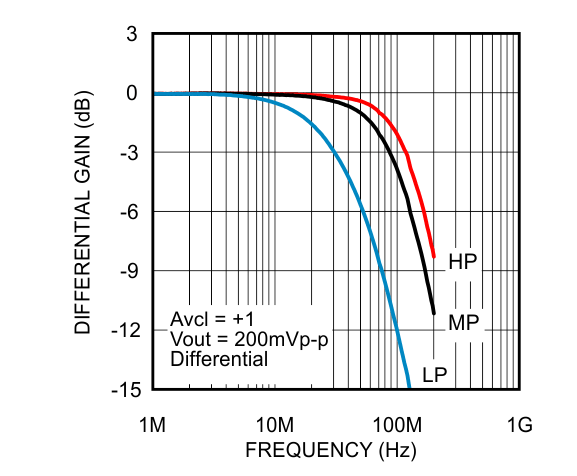 Figure 1. Frequency Response at 10 V
Figure 1. Frequency Response at 10 V
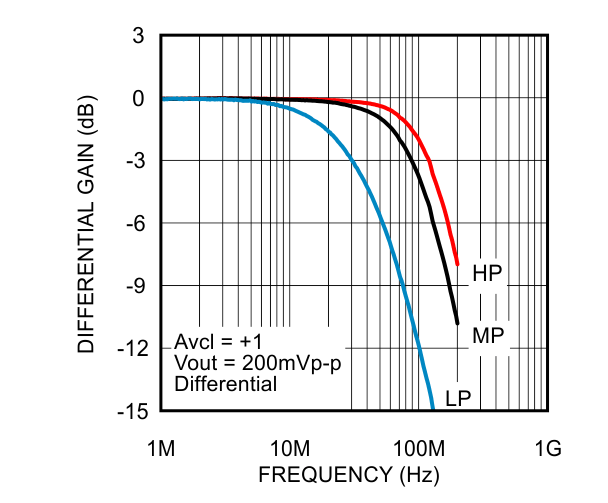 Figure 3. Frequency Response at 6.6 V
Figure 3. Frequency Response at 6.6 V
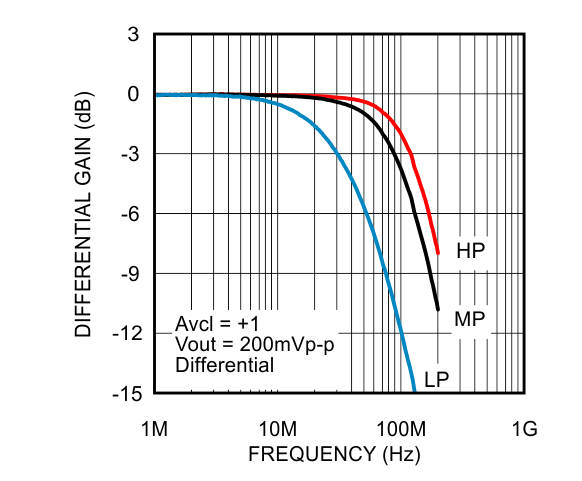 Figure 5. Frequency Response at 5 V
Figure 5. Frequency Response at 5 V
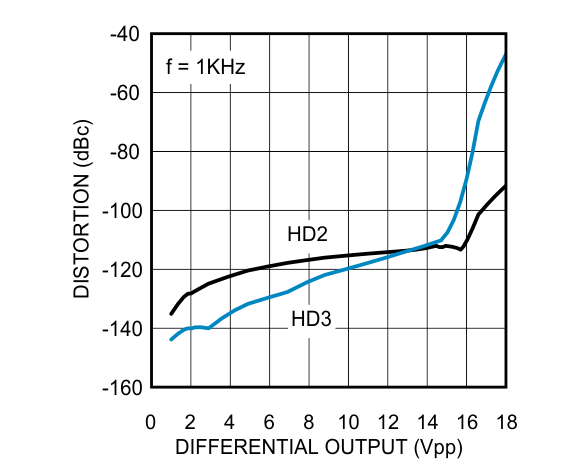 Figure 7. Distortion at 10 V, High Power
Figure 7. Distortion at 10 V, High Power
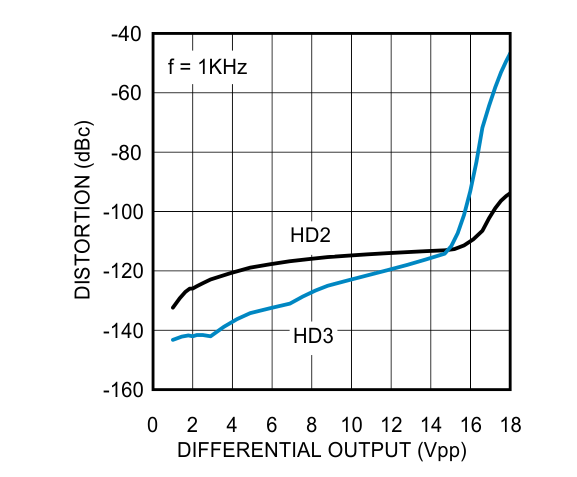 Figure 9. Distortion at 10 V, Mid Power
Figure 9. Distortion at 10 V, Mid Power
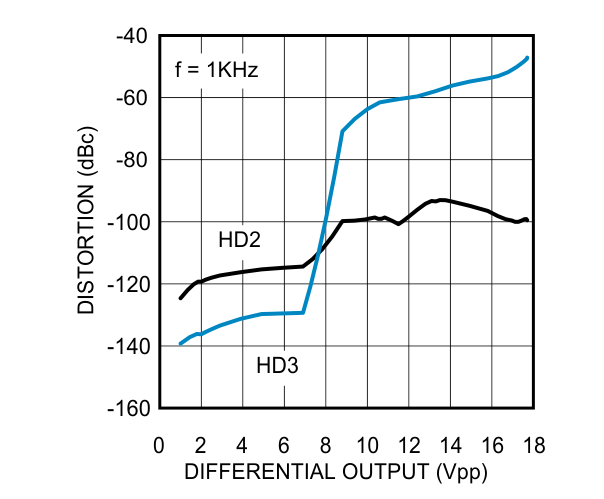 Figure 11. Distortion at 10 V, Low Power
Figure 11. Distortion at 10 V, Low Power
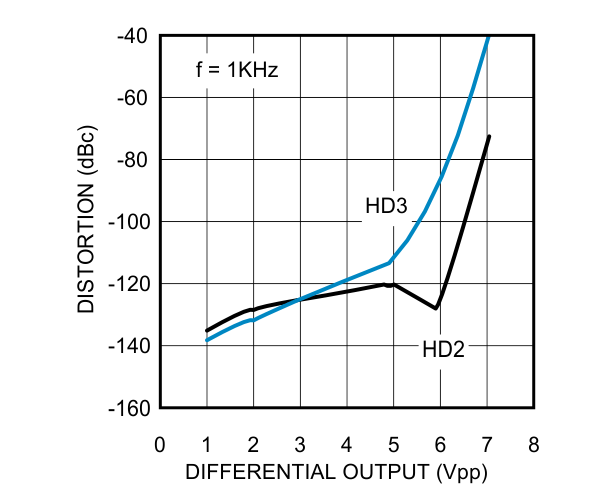 Figure 13. Distortion at 5 V, High Power
Figure 13. Distortion at 5 V, High Power
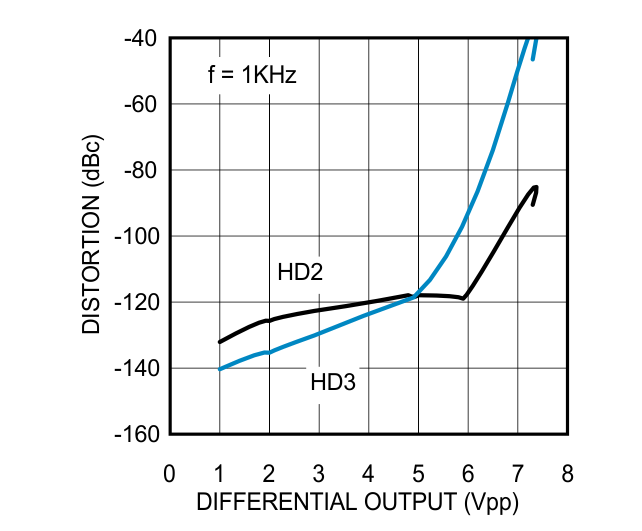 Figure 15. Distortion at 5 V, Mid Power
Figure 15. Distortion at 5 V, Mid Power
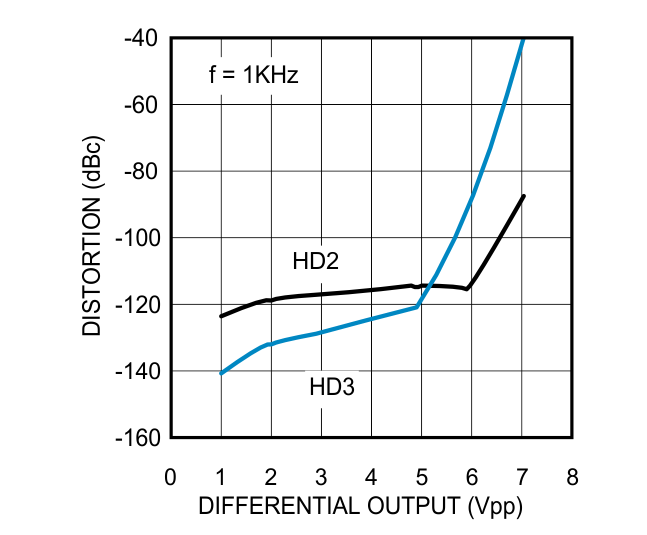 Figure 17. Distortion at 5 V, Low Power
Figure 17. Distortion at 5 V, Low Power
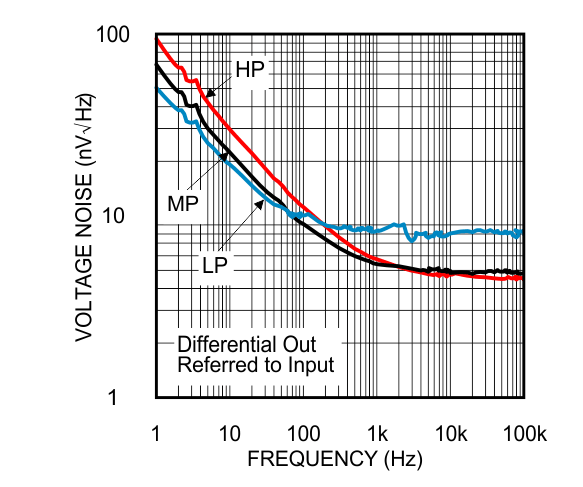 Figure 19. Voltage Noise at 10 V
Figure 19. Voltage Noise at 10 V
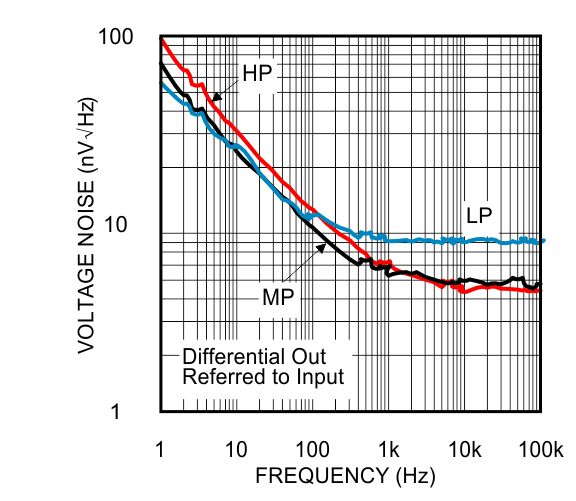 Figure 21. Voltage Noise at 6.6 V
Figure 21. Voltage Noise at 6.6 V
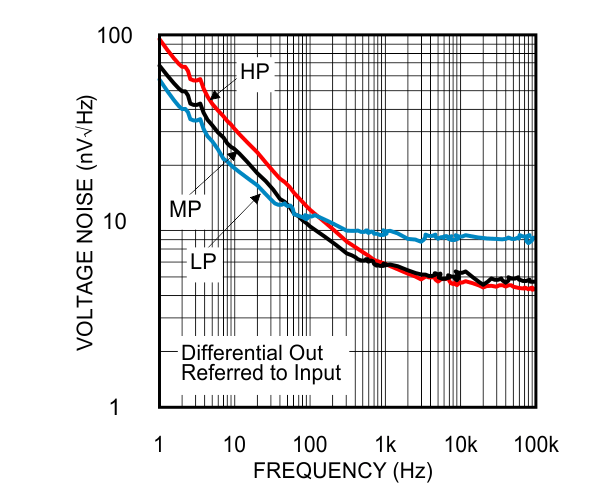 Figure 23. Voltage Noise at 5 V
Figure 23. Voltage Noise at 5 V
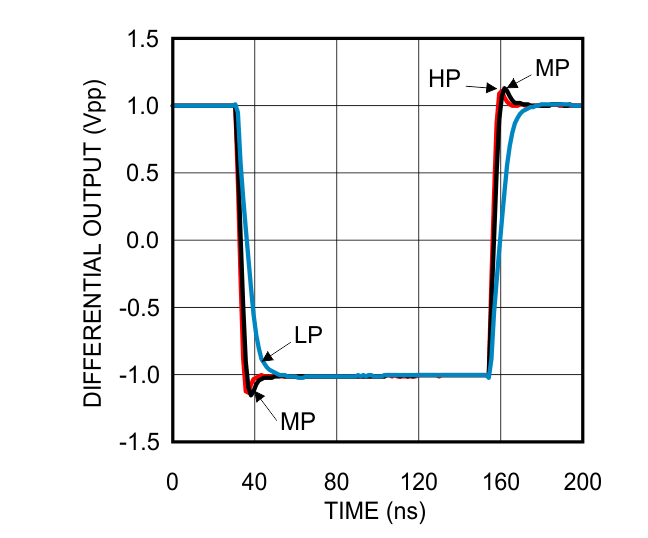 Figure 25. Pulse Response at 10 V
Figure 25. Pulse Response at 10 V
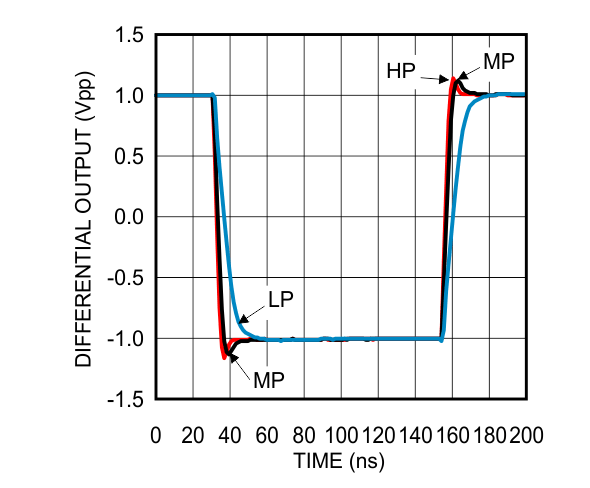 Figure 27. Pulse Response at 5 V
Figure 27. Pulse Response at 5 V
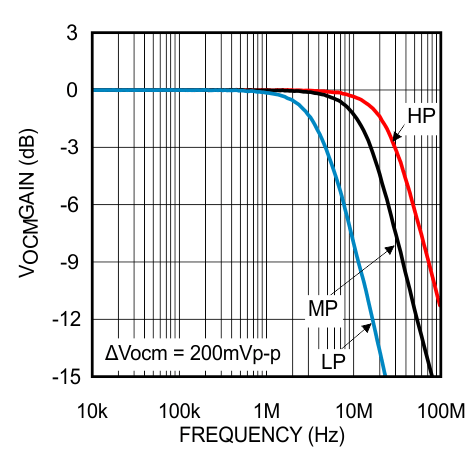 Figure 2. VOCM Frequency Response at 10 V
Figure 2. VOCM Frequency Response at 10 V
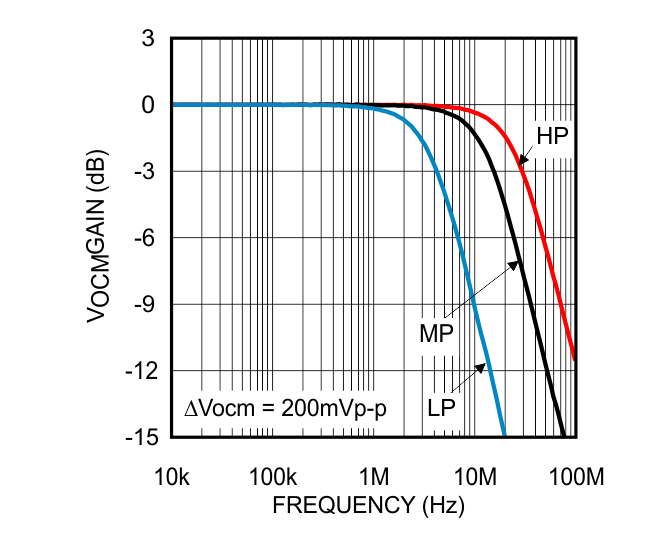 Figure 4. VOCM Frequency Response at 6.6 V
Figure 4. VOCM Frequency Response at 6.6 V
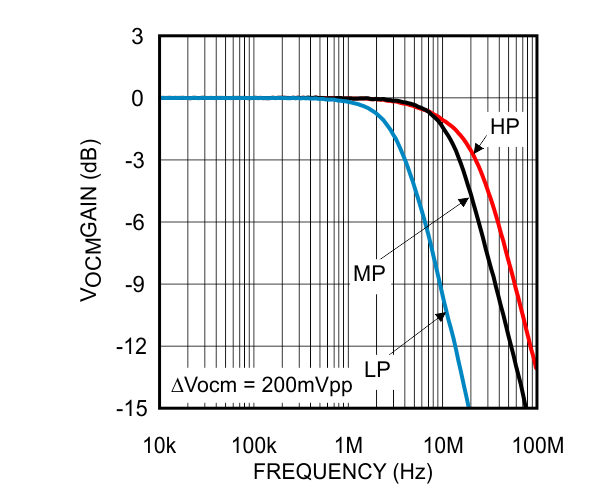 Figure 6. VOCM Frequency Response at 5 V
Figure 6. VOCM Frequency Response at 5 V
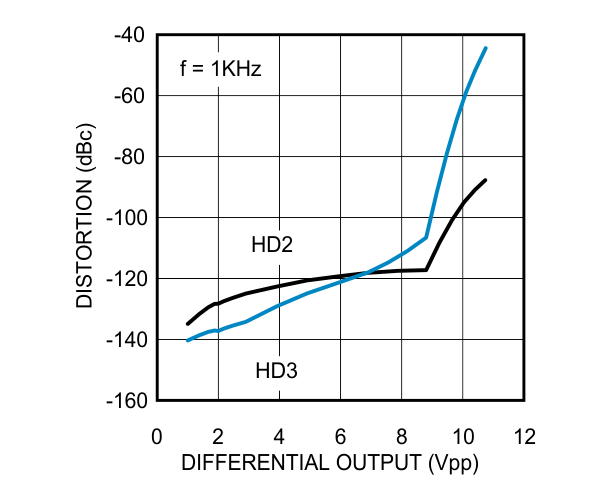 Figure 8. Distortion at 6.6 V, High Power
Figure 8. Distortion at 6.6 V, High Power
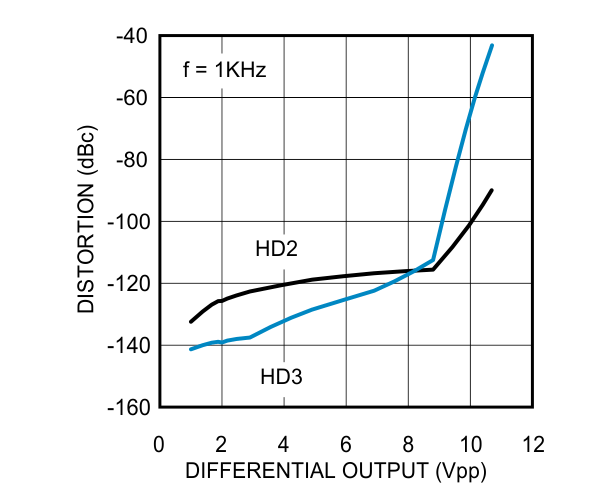 Figure 10. Distortion at 6.6 V, Mid Power
Figure 10. Distortion at 6.6 V, Mid Power
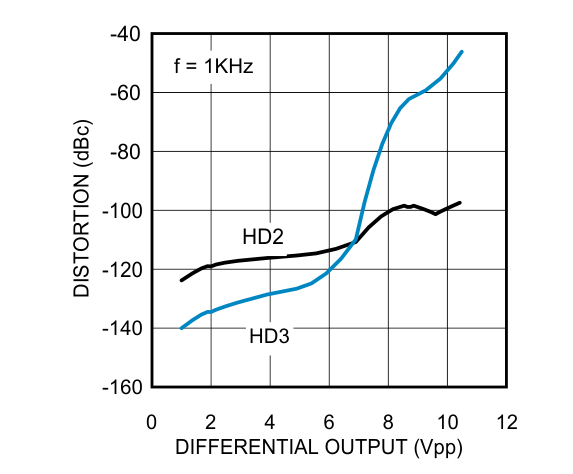 Figure 12. Distortion at 6.6 V, Low Power
Figure 12. Distortion at 6.6 V, Low Power
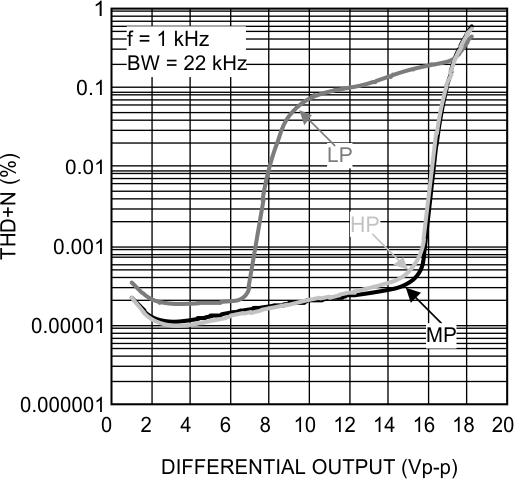 Figure 14. THD+N at 10 V
Figure 14. THD+N at 10 V
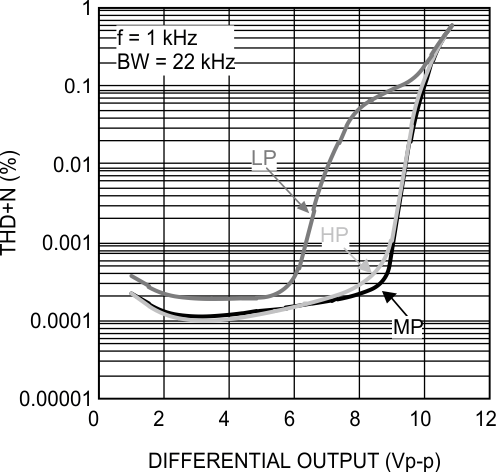 Figure 16. THD+N at 6.6 V
Figure 16. THD+N at 6.6 V
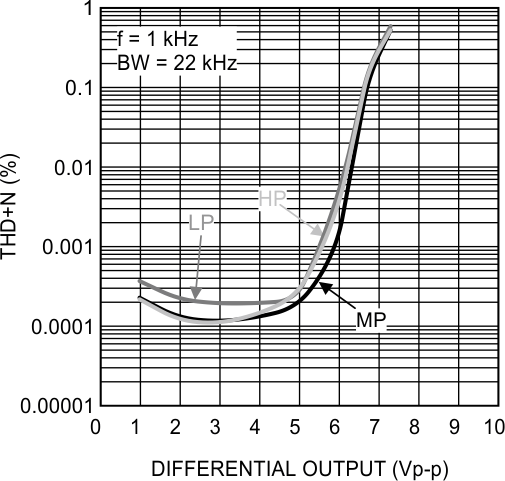 Figure 18. THD+N at 5 V
Figure 18. THD+N at 5 V
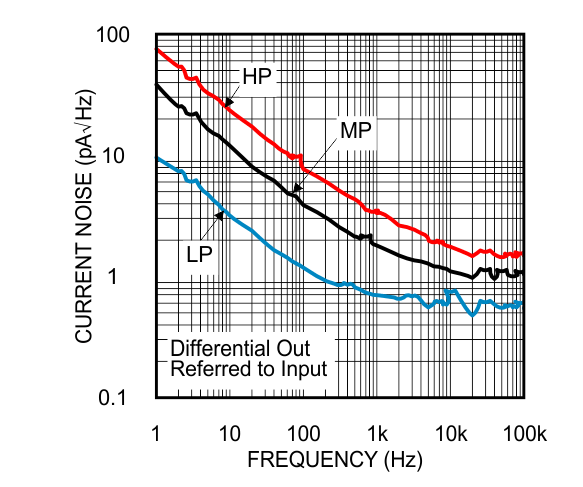 Figure 20. Current Noise at 10 V
Figure 20. Current Noise at 10 V
 Figure 22. Current Noise at 6.6 V
Figure 22. Current Noise at 6.6 V
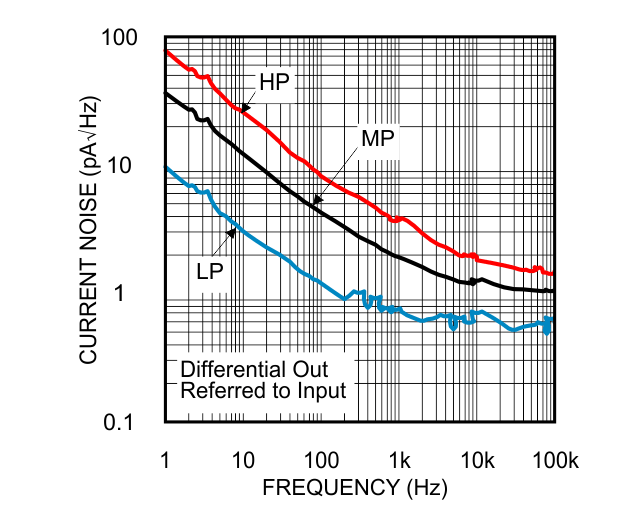 Figure 24. Current Noise at 5 V
Figure 24. Current Noise at 5 V
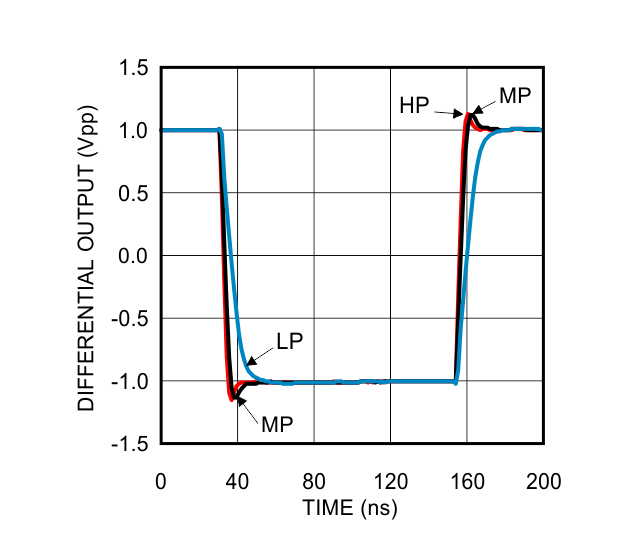 Figure 26. Pulse Response at 6.6 V
Figure 26. Pulse Response at 6.6 V